Egypt
Kronos
Man's first thought, after looking up at the heavens, was what am I and what am I looking at? These 2 questions have prevailed in man's thinking and have motivated man in his quest for knowledge. The first question to analyse is our solar system, it's mechanics and it's purpose.
The early Sumerians knew of seven planets, which they drew in their reliefs. These were from Mercury to Saturn, but today we observe only six. How is it then that the Sumerians were able to see a seventh planet which they named Nibiru? They were able to describe it in infinite detail; it's colour, it's location in the night sky, and even when the planet could be best viewed. For what reason would an ancient people lie about giving so much detail about the existence of a seventh planet?
The location of planets throughout the solar system follows a law of physics. This law is called Bode's Law. This law simply states by mathematical formula the location of where planets should exist, in their orbits around the sun. This law gives rise to the fact that the existing asteroid belt, which orbits the sun between Mars and Jupiter, was once a planet. This planet existed prior to the asteroids and was visible by the early Sumerians. The Sumerian earliest known calendar dates back to 10,860 B.C. as indicated by their earliest Zodiac sign, so that would mean that ancient man, observed this seventh planet, since 10,860 B.C. (Age of Aquarius blog) This planet for reasons unclear, exploded into the asteroid belt.
By simple observation the solar system has several note worthy distinctions
1st The inner four planets, (Mercury to Mars) are distinctly different than the outer four planets (Jupiter to Neptune). These two grouping of 4 planets are separated by the asteroid belt.
2nd The inner four planets have thin atmospheres, if any at all, while the outer four have a very thick, heavy and almost liquid atmosphere that travel at a very high speed of rotation.
3rd The inner planets have very high specific gravity numbers, while the outer four have very low s.g. numbers, closer to 1. In fact Saturn's specific gravity is less than 1, which would mean Saturn could actually float on water. The average specific gravity of the outer four planet, (including the Sun) is about 1.3.

This lends itself to an interesting conclusion. Were all the planets at one time similar to the outer four, with thick liquid atmospheres, and with low specific gravity numbers? All planets have a solid core, beneath the atmosphere and at one time had a molten iron inner core that produces the planet's magnetic field. This can only produce a very high s.g. numbers.To arrive at much lower s.g. numbers a very thin, light atmosphere must make up the majority of these outer planets atmospheres. The observable heavy thick atmosphere must then makeup only the very outer limits of these 4 planets atmospheres. Without this thin inner atmosphere the s.g. numbers just cannot be attained.
This 2 step atmosphere that in the past existed throughout the solar system including the inner 4 planets would give rise to a very different climate condition and geography on Earth and Mars, than we see today. This outer thick atmosphere would create a green house effect on the earth.
Since the outer atmospheres are orbiting about these planets at high velocities, they would not contribute to high atmospheric pressure on the planets surface. Instead they would orbit the planet as a satellite would.
We know that at one time in our history, earth had a tropical climate over all of it's geography. This allowed for large plant life that would support numerous large reptiles to roam the planet. Mars history also supported large amounts of water,as recently discovered, which could have also supported possibly animal and plant life. The 2 step atmosphere all gave rise to this occurring.
This all changed in an instance, resulting from a catastrophic reaction. Mars lost all of it's atmosphere, and eventually through time and the coldness of space solidified it's molten core. With the freezing of it's molten core Mars lost it's magnetic field. Earth had a similar fate though less dramatic.
What would cause this result. Only one event occurred that could bring these horrific conditions.The exploding of this seventh planet, now observed as the asteroid belt. The reason for this explosion will never be known, but the event did occur.
Kepler's third law clearly indicates that there is a planets missing between Mars and Jupiter, which is shown using a graph of values of "a" or astronomical units.
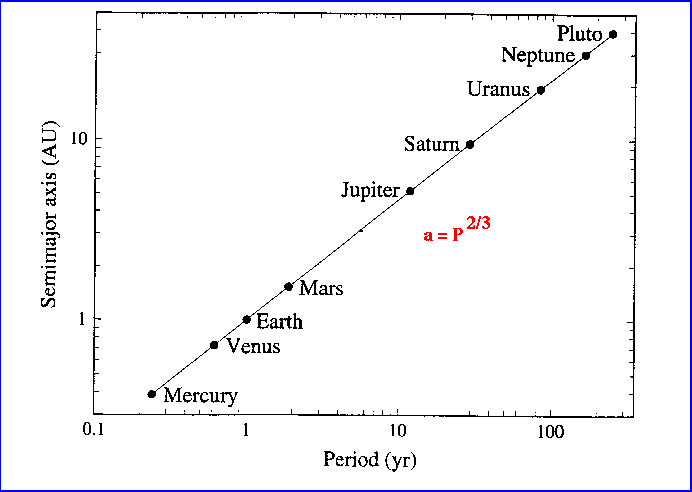
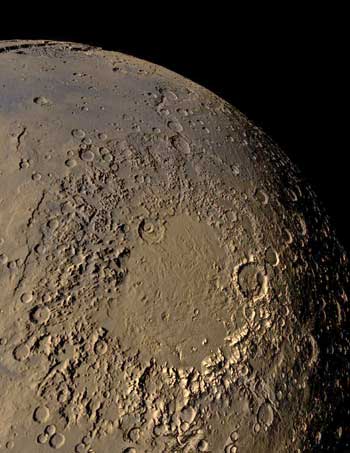
The southern hemisphere of Mars pictured above shows the results of the asteroid collisions resulting from the exploding of the 7th planet. Mars like earth is tilted on it's axis to give the planet seasonal changes. In the case of Mars this tilt is 25 degrees. By comparing the Northern Hemisphere with the Southern Hemisphere a noticeable difference is evident. The northern 1/2 of the planet has remarkable few asteroid craters, which indicates that the southern 1/2 of the planet was tilted towards this massive event of the exploding 7th planet and received the majority of the damage.
At first the broken planet's material, now known as asteroids, took a linear path from the point of the explosion, but this over time turned elliptical. Much of the lighter material, or heavy gravel like material, along with now frozen atmosphere gases, was quickly absorbed by the nearest 2 gas giants, Jupiter and Saturn gravitational forces. This material can today be seen as rings around these 2 planets. Much of the heavier asteroids would be consumed by the sun, but they also would cause numerous collisions through out the solar system, now seen as craters.
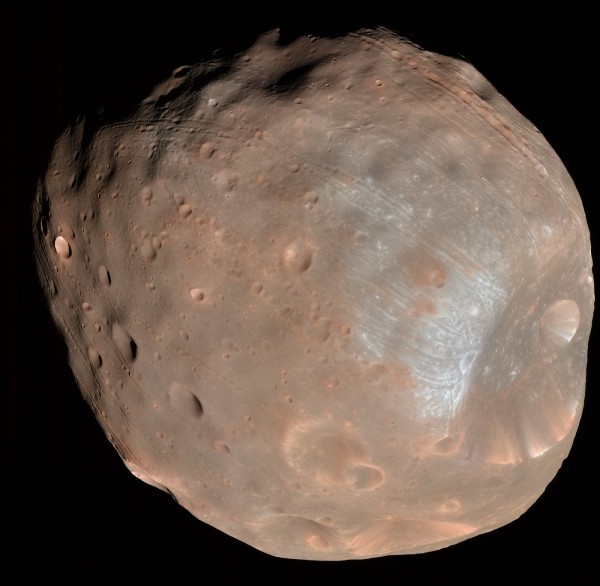
Phobos (fig, above) one of the two moons of Mars shows the severe amount of crater damage that occurred due to this event. Mars moons in comparison to other moons, have the most crater damage in the solar system, This indicates that Mars was the closest to this epic event.
Many scientists today do not believe that the asteroid belt, could at one time have been a planet, simply because the mass of the asteroid belt is too low. One must remember that most of the planets mass would of been easily consumed by the Sun, leaving only a small portion to form asteroids.
A point to consider when determining the origin of meteorites is they once contained the metal Beryllium 10. This metal has been determined to have existed in meteorites in their past. Beryllium 10 is only formed by collisions of very energetic particles with a heavy molecule like Oxygen. The resulting isotope Beryllium 10 quickly decays, so it must have been produced just before it was incorporated into the meteor.
This all points to the asteroids of the exploding planets having massive collisions with the planets Earth and Mars atmospheres which contained oxygen. In the resulting catastrophic contact, meteors or fragments of the asteroid penetrated the earths atmosphere, which we have examples today.
An interesting observation of the moons throughout the solar system, is their asteroid craters, and the configuration of these craters. Moons do not rotate on their own axis, but one side of the moon always faces the planet. Just like a car driving through a hail storm, the leading edge of the car or the front will sustain more hail damage v.s. the trailing edge or the rear of the car. This simple fact is also the same with the moons as they plowed through the asteroid hail like conditions. The leading edges of moons through out the solar system have 7 to one and as much as 9 to one more crater damage on their leading edges v.s. their trailing edges. This all points to the fact that asteroid damage was all a result of this 7th planet exploding from within the solar system, and NOT from outer space or from the Universe at large. Most if not all experts have these asteroid crater occurring over 100's of billions of years, but this is not the case. Most of these craters occurred over a mere 250 year period.
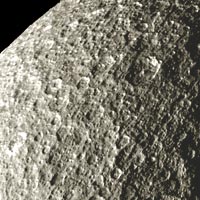
The image of Rhea ,a moon of Saturn, shows it's leading edge and the numerous asteroid craters, almost too many to count, while the trailing edge has a noticeable fewer amount.
More important to us, is what conditions resulted form these horrific asteroid collisions with earth. Earth like Mars had its atmosphere sheared off in the numerous collisions with asteroids. Mars suffered the worst simply because of it's close proximity to the 7th planet, and it's smaller size.This thick liquid water vapour and CO2 upon entering space froze and soon entered into an orbital path around the sun.This is the reason that comets are made of water, CO2 and dust. They are results of Mars and Earths once having a 2 step atmosphere similar to the outer 4 planets.
These former atmospheres are now what make up the composition of the comets. Much of Earth's outer atmosphere though, fell to the earth as a heavy torrential rain giving rise to the Biblical flood. The reason earth's outer atmosphere fell as rain, is because as the asteroids collided with the outer atmosphere it disturbed the atmospheres rotational speed, and like satellites of today, once they lose their orbital speed they fall to earth.
With the earth losing it's green house effect, the effects were almost instant. The poles froze, with temperatures falling all over the earth's surface. This produced the earths glacial period. Large reptiles and mammals literally froze to death with food in their mouths.Most of them drowned first, then froze, as the waters around them turned to ice. Accounts of large groups of mammals and reptiles grouped together as if drowned in a heavy flood, are common in modern digs. Millions of species of plant life and animal life would have disappeared forever.
Not just the earths climate faced massive changes, but the earth's geography would have drastically change. Water levels rose dramatically. You can now dive blue holes in the gulf of Mexico, and find at depths of 160 feet there is caves that have stalagmites. We know that these formations take thousands of years to form, from dripping water, that are now 160 feet below the surface. Mankind was left isolated on various islands through out the Pacific, as water levels rose. Easter Island and numerous tropical islands are a result of traumatic geographic changes.
There is an even greater and more far reaching effect from Earth losing it's outer atmosphere, than climate and geographic changes.Sumerian text and the Bible speaks of mankind living hundreds and even a thousand years, before the period of the flood.
This extended life expectancy dramatically changed after the flood. Not just one account but in many records of man's life, prior to the flood, including the Bible, man's life is measured in hundreds of years. Even today, most life scientists cannot understand why man only lives some 70 years. The human body is perfect in every manner, so why the limit to life?
The Real Question; When did this event occur?
By the dating of the Sumerian calendars, this event had to occur after 10,860 B.C., because that date is the first known calendar of the Sumerians. We know that the Sumerians knew of 7 planets from Mercury to Saturn. They called the 7th planet, Nibiru, which now exists as the asteroid belt.
{Age of Aquarius Mankind's first Calendar BLOG}
The cataclysmic event that caused the exploding of that planet resulted in Mars losing it's atmosphere and Earth, at the same time, losing it's Dinosaur population. Can this event be dated?
Can there be a way of cross referencing the dating of this event, other than the Sumerian calendar? Yes.
There is ancient cave drawing of Dinosaurs in places through out the earth that show known spices of Dinosaurs that were drawn less than 10,000 BC.
These 2 facts in effects, cave drawings and the Sumerian calendar, date the event of the destruction of the 7th planet.
Many date that Dinosaurs went extinct 65 to 75 million years ago, but is this well founded?
{Why is it difficult to advance knowledge BLOG}
Asteroids or Moons
In the asteroid belt there is two large moon like asteroids. Vesta and Ceres. The question many are asking. Are they former moons, planets or are they indeed asteroids?
There is a way to distinguish planets from moons. Planets have large topographical variations, while moons have a much more smoother surfaces. Planets have volcanoes, large mountains ranges, riffs and deep canyons, much of this caused by shifting plates. Moons on the other hand are more static in their formations. Planets have a rotational spin, and with the exception of Mars, a magnetic field, though Mars at one time did have a magnetic field. Planets in contrast to moons, for the most part, have an atmosphere or remnants of one. Titan, the exception, is a moon that has a very heavy atmosphere, and it's atmosphere is said to have an unusual anti-greenhouse effect. Another moon which is an exception is Triton, which is thought to have volcanoes, and moves around it's planet in the opposite direction to all other moons.
This lends itself to the fact that both of these asteroids, are neither asteroids or planets but are former moons of the planet Nibiru, and are now just tumbling rock inside the asteroid belt.
Ceres asteroid
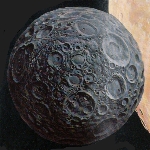
Vesta asteroid
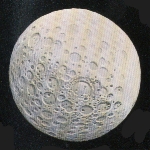
The Kuiper Belt
Just past the orbit of Neptune is a belt very similar to the asteroid belt. While the asteroid belt is made up of rock like material with high specific gravity, the Kuiper is made up of material very similar to the comets. Much of the mass of the Kuiper Belt is frozen water, C02, ammonia and frozen methane.
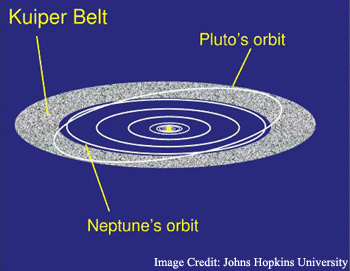
So why the two belts, one made up of planet rock material, and the other Belt of much lighter frozen ice material that exists further out from the Sun? The reason for the two distinct belts is the asteroid belt is the remnants of the 7th planet, and because of the asteroids higher mass, this formed into a belt much closer to the Sun,which is in contrast to the Kuiper belt which has a much lighter mass material makeup. The Kuiper Belt was formed from the disintegration of the 7th planet's, Nibiru and Mars's atmosphere. Some of the mass of these two atmospheres would have formed into comets, some would of been grabbed by the two gas giants, and formed into their rings, but for the most part they ended up orbiting the Sun from a great distance. This resulted in what we see today as the Kuiper Belt
For further readings;
http://trueancienthistory.blogspot.ca/2012/11/time-and-space-contraction.html
- Online: Le Musée Egyptien
DigiZeitschriften Thanks to Chuck Jones and his Ancient World Online blog for this link. Le Musée Egyptien al-Mathaf al-Misrī 1909-1915 Le Musée Egyptien Band 3 1904-1907 Le Musée Egyptien Band 2 ...
- Straw Walker's Time Space Calculations
Calculating Space Contraction A star's ability...
- The Ancient Calendar Of The Akkadians Compared To Modern Jewish Calendar
The Akkadian Calendar ...
- Portents, Signs And Prophecy
Portents, Signs and Prophecy I'll be honest, I'm...
- The Cash Register In The Desert
"Even though we had allowed people to take pictures in the Valley, people continued to bribe the guards and take cameras into the tombs and use flash." ...
Egypt
Kronos the Beginning
Kronos
Man's first thought, after looking up at the heavens, was what am I and what am I looking at? These 2 questions have prevailed in man's thinking and have motivated man in his quest for knowledge. The first question to analyse is our solar system, it's mechanics and it's purpose.
The early Sumerians knew of seven planets, which they drew in their reliefs. These were from Mercury to Saturn, but today we observe only six. How is it then that the Sumerians were able to see a seventh planet which they named Nibiru? They were able to describe it in infinite detail; it's colour, it's location in the night sky, and even when the planet could be best viewed. For what reason would an ancient people lie about giving so much detail about the existence of a seventh planet?
The location of planets throughout the solar system follows a law of physics. This law is called Bode's Law. This law simply states by mathematical formula the location of where planets should exist, in their orbits around the sun. This law gives rise to the fact that the existing asteroid belt, which orbits the sun between Mars and Jupiter, was once a planet. This planet existed prior to the asteroids and was visible by the early Sumerians. The Sumerian earliest known calendar dates back to 10,860 B.C. as indicated by their earliest Zodiac sign, so that would mean that ancient man, observed this seventh planet, since 10,860 B.C. (Age of Aquarius blog) This planet for reasons unclear, exploded into the asteroid belt.
By simple observation the solar system has several note worthy distinctions
1st The inner four planets, (Mercury to Mars) are distinctly different than the outer four planets (Jupiter to Neptune). These two grouping of 4 planets are separated by the asteroid belt.
2nd The inner four planets have thin atmospheres, if any at all, while the outer four have a very thick, heavy and almost liquid atmosphere that travel at a very high speed of rotation.
3rd The inner planets have very high specific gravity numbers, while the outer four have very low s.g. numbers, closer to 1. In fact Saturn's specific gravity is less than 1, which would mean Saturn could actually float on water. The average specific gravity of the outer four planet, (including the Sun) is about 1.3.

This lends itself to an interesting conclusion. Were all the planets at one time similar to the outer four, with thick liquid atmospheres, and with low specific gravity numbers? All planets have a solid core, beneath the atmosphere and at one time had a molten iron inner core that produces the planet's magnetic field. This can only produce a very high s.g. numbers.To arrive at much lower s.g. numbers a very thin, light atmosphere must make up the majority of these outer planets atmospheres. The observable heavy thick atmosphere must then makeup only the very outer limits of these 4 planets atmospheres. Without this thin inner atmosphere the s.g. numbers just cannot be attained.
This 2 step atmosphere that in the past existed throughout the solar system including the inner 4 planets would give rise to a very different climate condition and geography on Earth and Mars, than we see today. This outer thick atmosphere would create a green house effect on the earth.
Since the outer atmospheres are orbiting about these planets at high velocities, they would not contribute to high atmospheric pressure on the planets surface. Instead they would orbit the planet as a satellite would.
We know that at one time in our history, earth had a tropical climate over all of it's geography. This allowed for large plant life that would support numerous large reptiles to roam the planet. Mars history also supported large amounts of water,as recently discovered, which could have also supported possibly animal and plant life. The 2 step atmosphere all gave rise to this occurring.
This all changed in an instance, resulting from a catastrophic reaction. Mars lost all of it's atmosphere, and eventually through time and the coldness of space solidified it's molten core. With the freezing of it's molten core Mars lost it's magnetic field. Earth had a similar fate though less dramatic.
What would cause this result. Only one event occurred that could bring these horrific conditions.The exploding of this seventh planet, now observed as the asteroid belt. The reason for this explosion will never be known, but the event did occur.
Kepler's third law clearly indicates that there is a planets missing between Mars and Jupiter, which is shown using a graph of values of "a" or astronomical units.


The southern hemisphere of Mars pictured above shows the results of the asteroid collisions resulting from the exploding of the 7th planet. Mars like earth is tilted on it's axis to give the planet seasonal changes. In the case of Mars this tilt is 25 degrees. By comparing the Northern Hemisphere with the Southern Hemisphere a noticeable difference is evident. The northern 1/2 of the planet has remarkable few asteroid craters, which indicates that the southern 1/2 of the planet was tilted towards this massive event of the exploding 7th planet and received the majority of the damage.
At first the broken planet's material, now known as asteroids, took a linear path from the point of the explosion, but this over time turned elliptical. Much of the lighter material, or heavy gravel like material, along with now frozen atmosphere gases, was quickly absorbed by the nearest 2 gas giants, Jupiter and Saturn gravitational forces. This material can today be seen as rings around these 2 planets. Much of the heavier asteroids would be consumed by the sun, but they also would cause numerous collisions through out the solar system, now seen as craters.

Phobos (fig, above) one of the two moons of Mars shows the severe amount of crater damage that occurred due to this event. Mars moons in comparison to other moons, have the most crater damage in the solar system, This indicates that Mars was the closest to this epic event.
Many scientists today do not believe that the asteroid belt, could at one time have been a planet, simply because the mass of the asteroid belt is too low. One must remember that most of the planets mass would of been easily consumed by the Sun, leaving only a small portion to form asteroids.
A point to consider when determining the origin of meteorites is they once contained the metal Beryllium 10. This metal has been determined to have existed in meteorites in their past. Beryllium 10 is only formed by collisions of very energetic particles with a heavy molecule like Oxygen. The resulting isotope Beryllium 10 quickly decays, so it must have been produced just before it was incorporated into the meteor.
This all points to the asteroids of the exploding planets having massive collisions with the planets Earth and Mars atmospheres which contained oxygen. In the resulting catastrophic contact, meteors or fragments of the asteroid penetrated the earths atmosphere, which we have examples today.
An interesting observation of the moons throughout the solar system, is their asteroid craters, and the configuration of these craters. Moons do not rotate on their own axis, but one side of the moon always faces the planet. Just like a car driving through a hail storm, the leading edge of the car or the front will sustain more hail damage v.s. the trailing edge or the rear of the car. This simple fact is also the same with the moons as they plowed through the asteroid hail like conditions. The leading edges of moons through out the solar system have 7 to one and as much as 9 to one more crater damage on their leading edges v.s. their trailing edges. This all points to the fact that asteroid damage was all a result of this 7th planet exploding from within the solar system, and NOT from outer space or from the Universe at large. Most if not all experts have these asteroid crater occurring over 100's of billions of years, but this is not the case. Most of these craters occurred over a mere 250 year period.

The image of Rhea ,a moon of Saturn, shows it's leading edge and the numerous asteroid craters, almost too many to count, while the trailing edge has a noticeable fewer amount.
More important to us, is what conditions resulted form these horrific asteroid collisions with earth. Earth like Mars had its atmosphere sheared off in the numerous collisions with asteroids. Mars suffered the worst simply because of it's close proximity to the 7th planet, and it's smaller size.This thick liquid water vapour and CO2 upon entering space froze and soon entered into an orbital path around the sun.This is the reason that comets are made of water, CO2 and dust. They are results of Mars and Earths once having a 2 step atmosphere similar to the outer 4 planets.
These former atmospheres are now what make up the composition of the comets. Much of Earth's outer atmosphere though, fell to the earth as a heavy torrential rain giving rise to the Biblical flood. The reason earth's outer atmosphere fell as rain, is because as the asteroids collided with the outer atmosphere it disturbed the atmospheres rotational speed, and like satellites of today, once they lose their orbital speed they fall to earth.
With the earth losing it's green house effect, the effects were almost instant. The poles froze, with temperatures falling all over the earth's surface. This produced the earths glacial period. Large reptiles and mammals literally froze to death with food in their mouths.Most of them drowned first, then froze, as the waters around them turned to ice. Accounts of large groups of mammals and reptiles grouped together as if drowned in a heavy flood, are common in modern digs. Millions of species of plant life and animal life would have disappeared forever.
Not just the earths climate faced massive changes, but the earth's geography would have drastically change. Water levels rose dramatically. You can now dive blue holes in the gulf of Mexico, and find at depths of 160 feet there is caves that have stalagmites. We know that these formations take thousands of years to form, from dripping water, that are now 160 feet below the surface. Mankind was left isolated on various islands through out the Pacific, as water levels rose. Easter Island and numerous tropical islands are a result of traumatic geographic changes.
There is an even greater and more far reaching effect from Earth losing it's outer atmosphere, than climate and geographic changes.Sumerian text and the Bible speaks of mankind living hundreds and even a thousand years, before the period of the flood.
This extended life expectancy dramatically changed after the flood. Not just one account but in many records of man's life, prior to the flood, including the Bible, man's life is measured in hundreds of years. Even today, most life scientists cannot understand why man only lives some 70 years. The human body is perfect in every manner, so why the limit to life?
The Real Question; When did this event occur?
By the dating of the Sumerian calendars, this event had to occur after 10,860 B.C., because that date is the first known calendar of the Sumerians. We know that the Sumerians knew of 7 planets from Mercury to Saturn. They called the 7th planet, Nibiru, which now exists as the asteroid belt.
{Age of Aquarius Mankind's first Calendar BLOG}
The cataclysmic event that caused the exploding of that planet resulted in Mars losing it's atmosphere and Earth, at the same time, losing it's Dinosaur population. Can this event be dated?
Can there be a way of cross referencing the dating of this event, other than the Sumerian calendar? Yes.
There is ancient cave drawing of Dinosaurs in places through out the earth that show known spices of Dinosaurs that were drawn less than 10,000 BC.
These 2 facts in effects, cave drawings and the Sumerian calendar, date the event of the destruction of the 7th planet.
Many date that Dinosaurs went extinct 65 to 75 million years ago, but is this well founded?
{Why is it difficult to advance knowledge BLOG}
Asteroids or Moons
In the asteroid belt there is two large moon like asteroids. Vesta and Ceres. The question many are asking. Are they former moons, planets or are they indeed asteroids?
There is a way to distinguish planets from moons. Planets have large topographical variations, while moons have a much more smoother surfaces. Planets have volcanoes, large mountains ranges, riffs and deep canyons, much of this caused by shifting plates. Moons on the other hand are more static in their formations. Planets have a rotational spin, and with the exception of Mars, a magnetic field, though Mars at one time did have a magnetic field. Planets in contrast to moons, for the most part, have an atmosphere or remnants of one. Titan, the exception, is a moon that has a very heavy atmosphere, and it's atmosphere is said to have an unusual anti-greenhouse effect. Another moon which is an exception is Triton, which is thought to have volcanoes, and moves around it's planet in the opposite direction to all other moons.
This lends itself to the fact that both of these asteroids, are neither asteroids or planets but are former moons of the planet Nibiru, and are now just tumbling rock inside the asteroid belt.
Ceres asteroid

Vesta asteroid

The Kuiper Belt
Just past the orbit of Neptune is a belt very similar to the asteroid belt. While the asteroid belt is made up of rock like material with high specific gravity, the Kuiper is made up of material very similar to the comets. Much of the mass of the Kuiper Belt is frozen water, C02, ammonia and frozen methane.

So why the two belts, one made up of planet rock material, and the other Belt of much lighter frozen ice material that exists further out from the Sun? The reason for the two distinct belts is the asteroid belt is the remnants of the 7th planet, and because of the asteroids higher mass, this formed into a belt much closer to the Sun,which is in contrast to the Kuiper belt which has a much lighter mass material makeup. The Kuiper Belt was formed from the disintegration of the 7th planet's, Nibiru and Mars's atmosphere. Some of the mass of these two atmospheres would have formed into comets, some would of been grabbed by the two gas giants, and formed into their rings, but for the most part they ended up orbiting the Sun from a great distance. This resulted in what we see today as the Kuiper Belt
For further readings;
http://trueancienthistory.blogspot.ca/2012/11/time-and-space-contraction.html
- Online: Le Musée Egyptien
DigiZeitschriften Thanks to Chuck Jones and his Ancient World Online blog for this link. Le Musée Egyptien al-Mathaf al-Misrī 1909-1915 Le Musée Egyptien Band 3 1904-1907 Le Musée Egyptien Band 2 ...
- Straw Walker's Time Space Calculations
Calculating Space Contraction A star's ability...
- The Ancient Calendar Of The Akkadians Compared To Modern Jewish Calendar
The Akkadian Calendar ...
- Portents, Signs And Prophecy
Portents, Signs and Prophecy I'll be honest, I'm...
- The Cash Register In The Desert
"Even though we had allowed people to take pictures in the Valley, people continued to bribe the guards and take cameras into the tombs and use flash." ...
